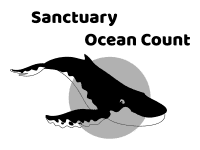Every year since 1996 volunteers have been counting the whales at many locations throughout the Hawaiian islands for the Sanctuary Ocean Count. That means that, for over 20 years now, hundreds of volunteers in Hawaii have documented many thousands of whale sightings!
Whale watching lessons learned from the Sanctuary Ocean Count
The results of this count are not easy to digest, but the general picture that emerges for the Big Island is the following:
- The Kohala coast is by far the best place to see humpback whales. Sightings here are sometimes two or three times more frequent than at other locations on the island.
- January and February are the best months the see whales at the Kohala coast. In March the total count number goes down by half, but there seem to be slightly more sightings on the Hamakua (northeast) coast.
- Early in the morning is the best time to see whales. The number of whale sightings on the Big Island at 8:00 am is ~50% higher than the amount spotted just a few hours later at noon. Another good reason for an early whale watch is the weather, as mornings are often calmer, meaning that the ocean surface is more glassy making it more easy to see whales.
- The average numbers for whale sightings fluctuate a lot. On average over all locations, between 3 and 6 whales were seen per 15-minute period in January and February. However, this average includes some sites with zero sightings and other sites with as many as 15-20.
Ocean Count data summary:
We list the results for the last 3 ocean counts below. Click here to see project results from the years before.
2020:
- January 25, 2020
- January 25, 2020 – Ocean Count & Whale Count Results Press Release
- February 29, 2020
- February 29, 2020 – Ocean Count & Whale Count Results Press Release
- March count: cancelled due to COVID-19.
2019:
- February 23, 2019
- February 23, 2019 – Ocean Count & Whale Count Results Press Release
- March 30, 2019
- March 30, 2019 – Ocean Count & Whale Count Results Press Release
2018:
Additional Resources:
Everybody willing to spend half a day looking at the ocean here in Hawaii can join the Sanctuary Ocean Count. See the following maps for the count locations on Oahu, Kauai and the Big Island, and learn more about registering for the count here.
Ocean Count Site Maps:
We are not affiliated with the Ocean Count effort on the Hawai’i islands but maintain this website to raise awareness about the ocean count. Find the official website for the Ocean Count at https://oceancount.org/
